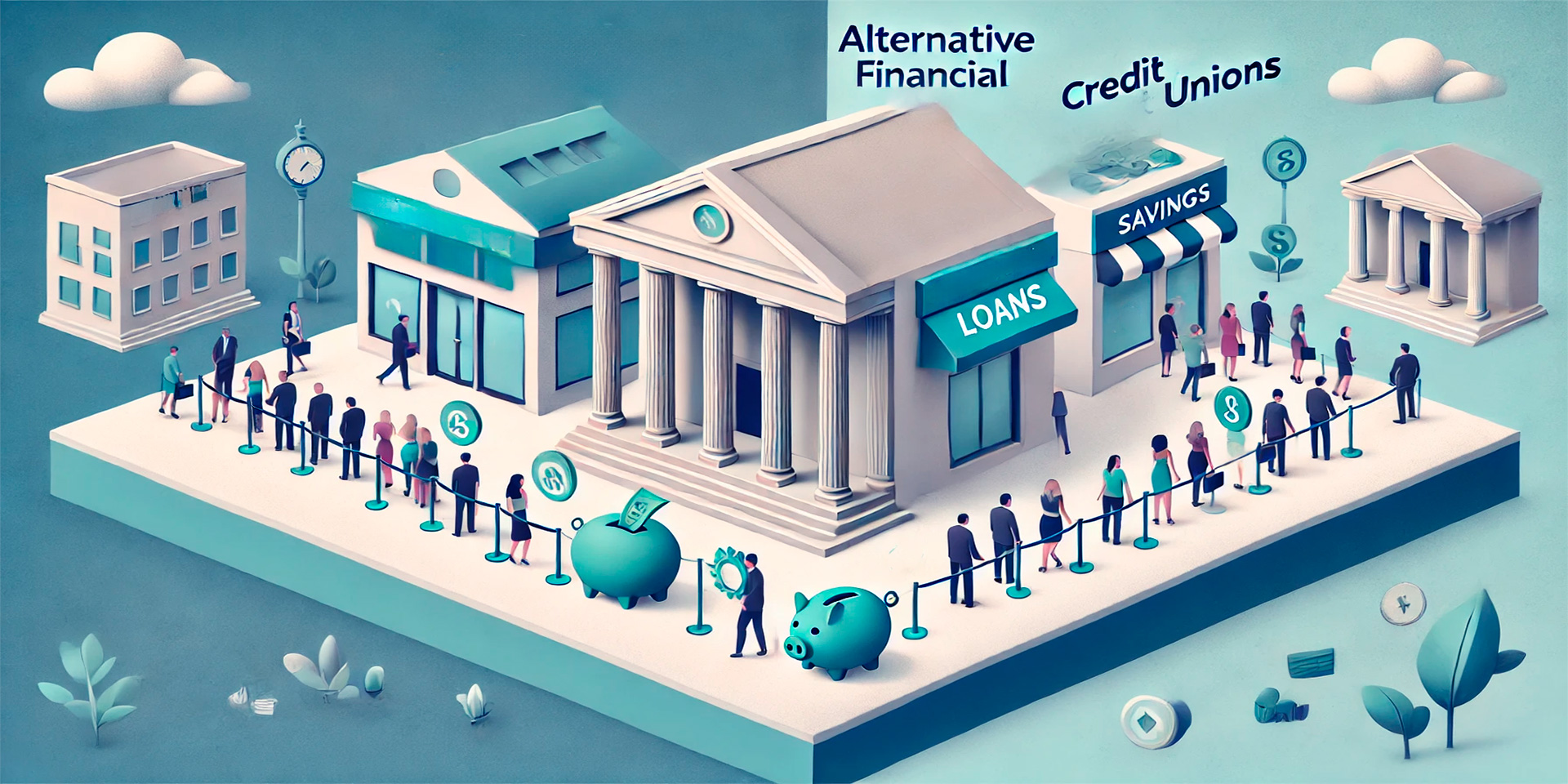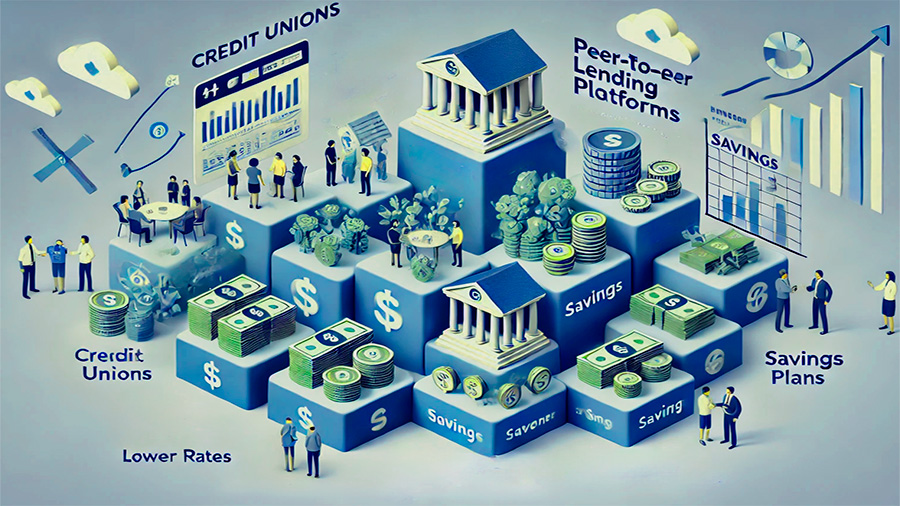Redefining Borrowing: How to Finance Your Needs Without Traditional Loans

Traditional loans, such as those offered by banks, have long been a common way to secure financing for major purchases, debt consolidation, or personal needs. However, these loans often come with rigid terms, high-interest rates, or lengthy approval processes that may not work for everyone. Fortunately, there are several alternative financial options available that can reduce dependency on traditional loans and provide more flexible, cost-effective solutions for borrowers.
This article explores alternative financial options like credit unions, peer-to-peer lending, savings plans, and other methods that can help you meet your financial needs without relying on conventional loans.
Why Look for Alternatives to Traditional Loans?
While traditional loans offer a structured way to borrow money, they are not always the most affordable or accessible option for everyone. High-interest rates, stringent approval requirements, and long-term debt commitments can make traditional loans less appealing, especially for those with limited credit history or low credit scores. Alternatives to traditional loans can offer greater flexibility, lower costs, and more accessible terms.
Many borrowers seek alternatives to reduce dependency on debt, avoid high-interest rates, or access financing more quickly. Exploring these options can help you find the right financial solution for your unique needs.
1. Flexible Terms and Lower Interest Rates
One of the main reasons borrowers seek alternatives to traditional loans is to access more flexible terms and lower interest rates. Conventional loans, especially unsecured personal loans, can come with high-interest rates that make repayment difficult. Alternatives like credit unions or peer-to-peer lending platforms often offer more favorable terms, including lower interest rates and more flexible repayment schedules.
Benefits of flexible financial options:
- Lower interest rates: Many alternative lenders offer interest rates that are more competitive than traditional banks.
- Customizable terms: Borrowers can often negotiate repayment terms that suit their financial situation, making it easier to manage debt.
2. Easier Access to Financing
Traditional loans often come with strict credit requirements, making it challenging for individuals with poor credit or limited credit history to qualify. Alternative financing options may offer more lenient approval criteria, providing access to funds for those who would otherwise be denied by traditional lenders. Additionally, some alternative lenders offer faster approval processes, which can be helpful for borrowers in need of quick cash.
How alternative financing offers easier access:
- Less stringent credit checks: Many alternative lenders focus on factors other than credit score, such as income or employment status, making it easier to qualify for loans.
- Faster approval: Peer-to-peer lending platforms and online lenders often have streamlined application processes that provide quick access to funds.

Alternative Financial Options to Explore
There are several alternative financial options available to those looking to avoid traditional loans. These options offer varying degrees of flexibility, accessibility, and cost-effectiveness, allowing borrowers to choose the best fit for their needs. Below are some of the most popular alternatives to traditional loans.
1. Credit Unions
Credit unions are member-owned financial institutions that often provide lower fees and interest rates compared to traditional banks. Because credit unions are non-profit organizations, their primary focus is serving their members rather than generating profits. This means they can offer more affordable loan options and personalized service. Credit union loans are typically available to individuals with lower credit scores, and the application process tends to be more flexible.
Advantages of credit union loans:
- Lower interest rates: Credit unions generally offer more competitive interest rates than traditional banks, making loans more affordable.
- Member-focused service: Credit unions prioritize member needs, offering more flexible loan terms and personalized service.
2. Peer-to-Peer Lending
Peer-to-peer (P2P) lending platforms connect borrowers directly with individual investors willing to lend money at competitive rates. P2P lending cuts out traditional financial institutions, allowing borrowers to access funds from a pool of individual investors. This model can offer more favorable terms and quicker approval compared to traditional loans. P2P lending is typically conducted through online platforms, making the process convenient and accessible to a wide range of borrowers.
Benefits of peer-to-peer lending:
- Competitive rates: P2P platforms often offer lower interest rates than banks because they connect borrowers directly with investors.
- Faster approvals: The application and approval process is typically faster and more streamlined, allowing borrowers to receive funds more quickly.
3. Savings Plans
One of the most effective alternatives to traditional loans is building a savings plan to avoid the need for borrowing altogether. By setting aside a portion of your income regularly, you can create an emergency fund or save for large purchases without incurring debt. Many financial institutions offer high-yield savings accounts, which allow you to earn interest on your savings, growing your funds over time.
How savings plans reduce dependency on loans:
- Emergency funds: Building an emergency fund ensures that you have access to cash when unexpected expenses arise, reducing the need for loans.
- Interest growth: High-yield savings accounts allow your savings to grow over time, providing a financial cushion for future needs.
4. Microloans
Microloans are small, short-term loans typically offered to individuals or small businesses that may not qualify for traditional loans. These loans are often provided by non-profit organizations, community development financial institutions (CDFIs), or specialized lenders that focus on helping underserved communities. Microloans are an excellent option for entrepreneurs, startups, or individuals needing a small amount of capital to cover immediate expenses.
Advantages of microloans:
- Accessibility: Microloans are designed for individuals and businesses that may not meet the criteria for larger loans, making them easier to access.
- Lower loan amounts: Microloans offer smaller loan amounts, which can be useful for covering short-term needs without taking on excessive debt.
5. Personal Lines of Credit
A personal line of credit functions similarly to a credit card but with lower interest rates and more flexible terms. It provides access to a predetermined amount of credit that borrowers can draw from as needed. Unlike a traditional loan, where you receive a lump sum upfront, a line of credit allows you to borrow only what you need and pay interest only on the amount used. This flexibility makes lines of credit an excellent option for managing ongoing or unexpected expenses.
How personal lines of credit work:
- Flexible borrowing: You can borrow as much or as little as you need, up to your credit limit, making lines of credit highly flexible.
- Interest on borrowed amounts: You only pay interest on the funds you use, not the total credit limit, helping reduce costs.
6. 401(k) Loans
For individuals who have a retirement account such as a 401(k), borrowing from your retirement savings may be an option. Many employers allow participants to take out a loan against their 401(k) balance, which can be repaid over time with interest. While this can provide immediate access to cash, it’s important to consider the long-term impact on your retirement savings. Borrowing from your 401(k) can reduce the growth of your retirement funds, and if the loan is not repaid on time, it may be subject to penalties.
Pros and cons of 401(k) loans:
- Access to cash: A 401(k) loan allows you to borrow from your own savings, eliminating the need to deal with external lenders.
- Potential penalties: If the loan is not repaid within the required time frame, you may face penalties or taxes on the loan amount.

Choosing the Right Alternative for Your Financial Needs
When exploring alternatives to traditional loans, it’s essential to consider your financial goals, credit history, and the urgency of your needs. While some alternatives offer lower interest rates or more flexible terms, others may be better suited for individuals with specific borrowing requirements, such as small business owners or individuals with limited credit history. By understanding your options and comparing the benefits of each, you can make an informed decision that helps you meet your financial needs without relying on traditional loans.
1. Evaluate Your Financial Situation
Before choosing an alternative to traditional loans, assess your current financial situation. Consider factors such as your credit score, income stability, and the amount you need to borrow. Understanding your financial position will help you determine which alternative is most appropriate for your needs.
Steps to evaluate your financial situation:
- Review your credit score: Knowing your credit score can help you determine which alternative lending options are available to you.
- Consider your borrowing needs: Assess how much money you need and whether a short-term or long-term solution is best for you.
2. Compare Interest Rates and Terms
Different financial alternatives come with varying interest rates and repayment terms. Comparing these rates and terms will help you find the most cost-effective solution. Be sure to factor in any fees or penalties that may apply and consider the long-term impact on your financial health.
How to compare interest rates and terms:
- Look at APR: When comparing loans or credit lines, focus on the annual percentage rate (APR) to understand the true cost of borrowing.
- Review repayment schedules: Choose a repayment schedule that fits your budget and allows you to pay off the loan without financial strain.
Conclusion
While traditional loans are a popular way to finance large purchases or cover unexpected expenses, they are not the only option available. By exploring alternatives like credit unions, peer-to-peer lending, savings plans, and microloans, you can reduce your dependency on conventional loans and find more flexible, affordable solutions to meet your financial needs. Whether you’re looking for faster approval, lower interest rates, or more personalized service, there are many alternatives that can help you achieve your financial goals while minimizing debt.

